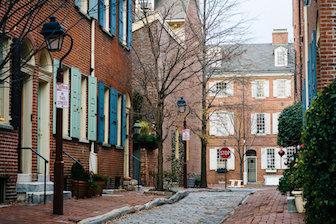
A brief history of residential architecture in Philadelphia
Philadelphia is steeped in architectural history. While much ado is given to masterpieces such as City Hall or the Union League, Philadelphia’s residential past is equally interesting.
Row houses
The first row houses to grace the new world were erected on what is now known as Sansom Street in Center City. Named Carstair’s Row after architect Thomas Carstair, the original homes were built in the in the early 1800s.
Over the years, most of these structures were updated and renovated. Only 700 Sansom Street still bears its original detail. The building is now the centerpiece of Jewelers’ Row, the oldest jewelry district in the nation.
A standard arrangement in London, row houses brought a new form of residential building to the United States. Row houses were a form of property speculation. An investor or developer would purchase an entire block of land and then sell off each unit once complete.
Signs of wear and tear
By the 1930s, approximately one century after the row house boom, many of these homes had fallen into disrepair. It was during this time when many of the city’s first apartment blocks and mid- to high- rise tenements were built. As these low-income houses was constructed in the city, many affluent residents chose to build luxury homes on larger estates in the surrounding countryside.
An urban renaissance
The late 1950s and 1960s witnessed an urban renewal at the hands of the Philadelphia Redevelopment Authority. Architects like George Howe, Wilson Eyre, Robert Venturi and Louis Kahn began to revitalize Philadelphia’s forgotten architectural masterpieces.
A shift to condominiums
The late 1990s brought the greatest shift in residential living since the row houses were razed. Tax breaks generated a condominium boom in Center City that has never slowed.
Rehabilitated historic buildings, converted into luxury condominiums, are now some of the most prestigious addresses in the city. The boom also led to the construction of new skyscraper-style high-end condos, often sharing space with 5-star hotels.
Philadelphia is steeped in architectural history. While much ado is given to masterpieces such as City Hall or the Union League, Philadelphia’s residential past is equally interesting.
Row houses
The first row houses to grace the new world were erected on what is now known as Sansom Street in Center City. Named Carstair’s Row after architect Thomas Carstair, the original homes were built in the in the early 1800s.
Over the years, most of these structures were updated and renovated. Only 700 Sansom Street still bears its original detail. The building is now the centerpiece of Jewelers’ Row, the oldest jewelry district in the nation.
A standard arrangement in London, row houses brought a new form of residential building to the United States. Row houses were a form of property speculation. An investor or developer would purchase an entire block of land and then sell off each unit once complete.
Signs of wear and tear
By the 1930s, approximately one century after the row house boom, many of these homes had fallen into disrepair. It was during this time when many of the city’s first apartment blocks and mid- to high- rise tenements were built. As these low-income houses was constructed in the city, many affluent residents chose to build luxury homes on larger estates in the surrounding countryside.
An urban renaissance
The late 1950s and 1960s witnessed an urban renewal at the hands of the Philadelphia Redevelopment Authority. Architects like George Howe, Wilson Eyre, Robert Venturi and Louis Kahn began to revitalize Philadelphia’s forgotten architectural masterpieces.
A shift to condominiums
The late 1990s brought the greatest shift in residential living since the row houses were razed. Tax breaks generated a condominium boom in Center City that has never slowed.
Rehabilitated historic buildings, converted into luxury condominiums, are now some of the most prestigious addresses in the city. The boom also led to the construction of new skyscraper-style high-end condos, often sharing space with 5-star hotels.
Today, luxury home buyers in Philadelphia are just as likely to purchase a well-appointed condo as they are a single-family property.

